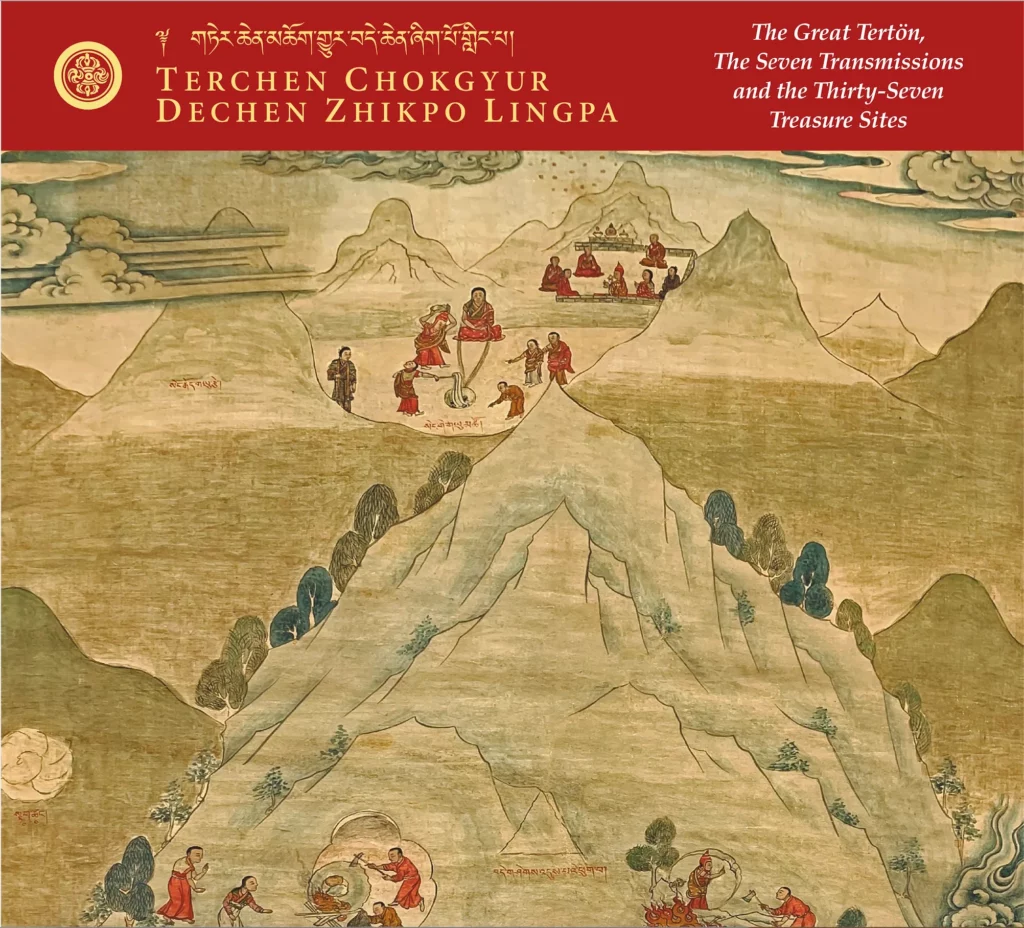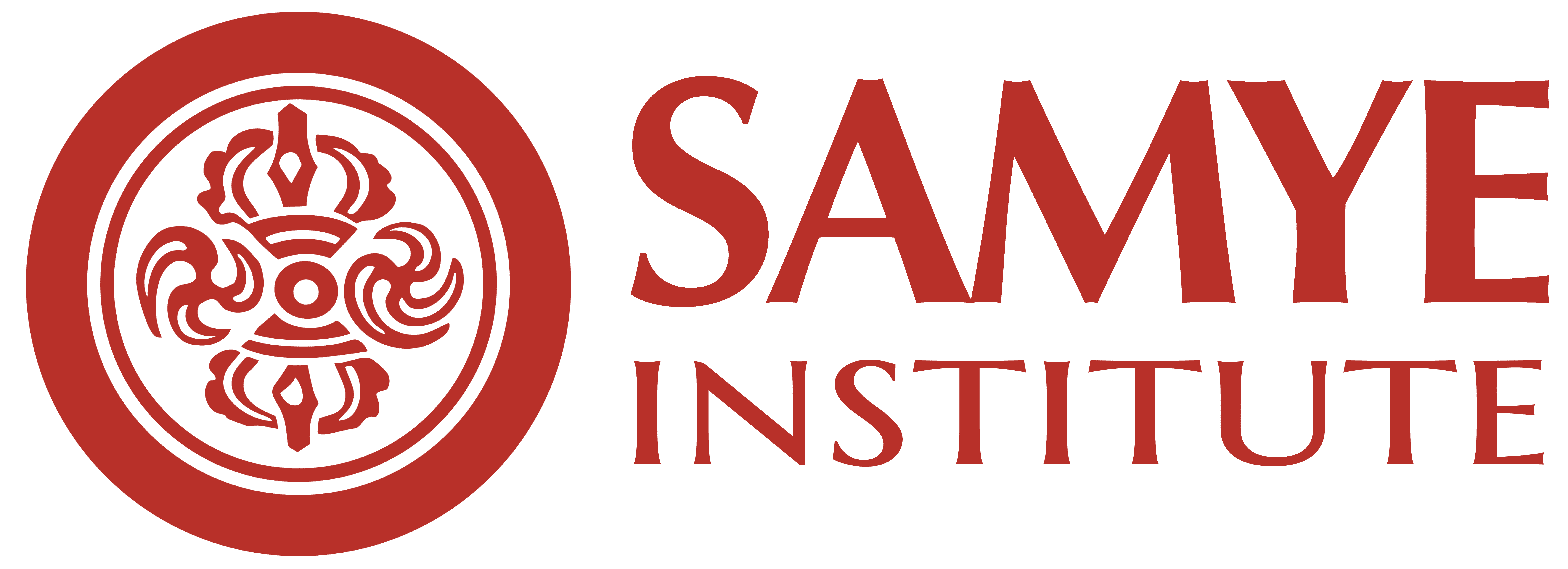Chokgyur Dechen Zhikpo Lingpa was born in Sangyel, at the base of the sacred mountain Namkhadzö in the province of Nangchen, Kham, in eastern Tibet on the tenth day of the sixth month of the earth ox year (August 9, 1829). It is said that Chokgyur Lingpa was the final reincarnation of Prince Murup Tsenpo, the second son of Dharma King Trisong Deutsen.
He was a contemporary of and collaborator with the Rimé masters Jamyang Khyentse Wangpo and Jamgön Kongtrul. These three masters related to each other as teacher and disciple, each regarding the other two as gurus. Chokgyur Lingpa, like Khyentse Wangpo, was entrusted with the seven special transmissions, as described in the Three Classes of the Great Perfection,
The unbroken Oral Lineage that comes from the scriptures,
the profound Actual Treasures and profound Mind Treasures,
the Rediscovered Treasures and the Recollected Treasures,
the Pure Vision Treasures and the Whispered Lineages—
the flowing river of these seven transmissions,
the foretold destiny of the king [Trisong Deutsen] and his son [Murup Tsenpo],
will bring honor to the teachings in degenerate times.
They will be profound and vast in reach, spreading further than sunlight.
His terma revelations, the Chokling Tersar, span over 40 volumes and include the Tukdrup Barché Kunsel, the Lamrim Yeshe Nyingpo, and the Three Classes of the Great Perfection.
For those who are not acquainted with his life story, you can find a concise presentation here written from an academic point of view, consulting numerous original sources. Chokgyur Lingpa himself recorded his own life in a text translated as Radiant Sunlight of the Victors’ Teachings.
Practitioners of the Chokling Tersar lineage can find more details in the indispensable book The Great Tertön, compiled by our in-house translation group, Samye Translations. This volume includes not only a history but also a collection of oral instructions. The Great Tertön presents the life stories of Guru Rinpoché, Chokgyur Lingpa, and all the subsequent Chokling incarnations.
In addition, our translators have gathered stories relating to a number of the main lineage masters. This line of transmission continues unbroken to this day with Phakchok Rinpoche. In traditional Tibetan literature classification, this genre of life stories is known as namthar (Tib. rNam thar). This term translates as “complete liberation”, and indicates that the lessons offered in this text focus on spiritual attainment.

Terchen Chokgyur Dechen Zhikpo Lingpa, also from Samye Translations, is a recent addition (2023) to the literature on Chokgyur Lingpa. This volume presents a full visual journey to all the treasure sites of the Great Tertön. Those who wish to experience and connect with the Great Tertön’s life and legacy will find this an essential companion on their journey.
Advice from Phakchok Rinpoche on Reading the Life Story of Chokgyur Lingpa
Phakchok Rinpoche advises students to read the liberation stories of masters while adopting a different perspective than usual study. He counsels that one can benefit most by reading with a humble and compassionate attitude:
Therefore, please relax your critical mind and try to generate some devotion and some pure perception…
Phakchok Rinpoche
Reflection on Celebrating the Parinirvāṇa
On the anniversary of Chokgyur Lingpa’s parinirvāṇa, we can reflect on the great devotion and faith demonstrated by the master. Here, we can turn to one of the accounts included in The Great Tertön, called “Nectar for the Ears of the Fortunate.” Könchok Gyurmé Tenpé Gyaltsen, the second incarnation of the tertön, narrated this account of Chokgyur Linpa’s Visionary Journey to the Copper-colored Mountain.
In this extraordinary voyage, the master journeys with the ḍākinīs, stopping at many sacred sites along the way. They stop at the site of the Buddha’s own parinirvāṇa, in modern Kushinagar.
Once they arrive there, we read that the Tertön “made supplications in a state of profound and irreversible faith, filled with admiration, yearning, and trust”. Also, his body hairs stood on end, and his face shown with tears.
And at that point the head ḍākinī advised him:
Son of noble family, it is taught that the Buddha never passes away, and the dharma likewise never disappears. Regarding the meaning of this:
In one’s own mind is the original buddha.
The Great Tertön, p. 256
Is this not what is called the sugata essence?
In the five-colored sphere in the center of your heart
The buddha resides, never parting.
Samādhi! Hoh, ah, ah, ah!
Supplication and Aspiration: Advice for Practitioners
Lhasey Lotsawa’s website regularly adds translations of pithy advice written by Chokgyur Lingpa for the benefit of practitioners just like us. One example is Some Advice to Take to Heart, a short verse that reminds us all how to check ourselves and practice correctly.
When we cultivate devotion to Chokgyur Lingpa, we can recollect these teachings and make the aspiration that all beings realize and remain in the natural state!
Phakchok Rinpoche reminds students of how best to practice specifically on the parinirvana anniversary. You can find that audio teaching here.
The anniversary day presents an excellent opportunity to reflect on the great kindness of the terton. This Supplication to Chokgyur Lingpa chanted by Khenpo Pema Namgyal elicits great devotion.


